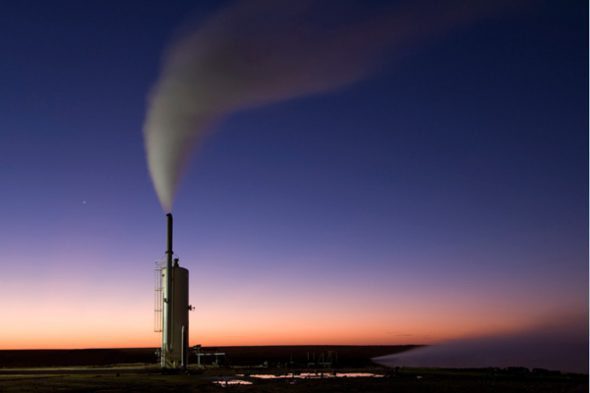Origin Energy is taking a hard-ball line in its geothermal venture with Geodynamics, refusing to pitch in more funds into a well program that has run over budget, and still yet to agree to a future works program.
The Habanero 4 well, in the Cooper basin, still regarded by some as the flagship well of Australia’s hot dry rocks geothermal ambitions, has run across some technical issues, causing several weeks of delays and several millions of dollars in cost over-runs.
Origin Energy, which has a 30 per cent interest in the Innamincka Deeps joint venture, last week said it would not put in more funds over the $48.5 million budget – meaning that the smaller, listed Geodynamics will have to meet the extra payments, currently estimated at nearly $3 million.
Origin Energy has taken a tougher line on the Innamincka Deeps program since writing off its $200 million investment a year ago, and declining to take up its share of a rights issue by Geodynamics earlier this year, causing its stake in the company to fall by less than 5 per cent.
It remains non-committal to Innamincka, saying it reserves the right to “jump back in” to the joint venture – and says it continues to investigate a range of geothermal options, which include ventures in Indonesia and Chile, as well as Australia. “This action reflects our disciplined approach to investment,” a spokesperson said.
Geodynamics CEO Geoff Ward said the delays and cost over-runs, caused by problems with the cement casing some 4km underground, were disappointing, but the company was confident it could be overcome.
Ward said Geodynamics had the funds to complete the well and to install its 1MW pilot plant near Innamincka – which would be the largest geothermal plant in Australia (there is only one other at Birdsville) and the first using hot dry rock technology, which seeks to exploit higher temperatures stored in super-heated rock deep underground.
Ward said it was a complex well – the deepest and hottest that cementing contractors Halliburton had ever done – and the cost over-run, while regrettable, was relatively minor and only came late in the program.
“I’m actually quite pleased as to how we have gone through it,” Ward told RenewEconomy on Monday.
The question remains about whether Origin Energy still believes that the asset still has a role to play in the Australian energy sector and is a “problem worth solving.” Such assessments have been complicated not just by the challenges of a new technology, but by revised demand forecasts which has reshaped the outlook for baseload generation in the country.
Origin Energy CEO Grant King indicated in an interview with RenewEconomy in February that the “unconventional geothermal play has got quite a long way to go, and got some challenges, and has probably missed the RET window”, indicating that no commercial projects of any scale would be up and running before 2020. (Interestingly, in the government’s draft energy white paper, some scenarios had geothermal accounting for more than a fifth of Australia’s energy production by 2050).
Paul Jensz, an analyst at Octa Phillip Securities, said the 1MW pilot plant could still justify the negotiation in the next two years of a take off agreement for a plant of up to 70MW in the Cooper Basin, possibly from resource customers such as Santos or BHP Billiton.
“If all goes according to plan by May 2013, then (Geodynamics) will have multiple options to develop: commercially proven Cooper Basin Deeps’ Resource; Geothermal Expertise; and cash reserve of $25 million,” Jensz wrote in a report. He rates Geodynamics as a “speculative buy” with a price target of up to 40c. It is currently at 11c, having plunged from 1997 levels of more than $2.
However, Jensz said that the possible change in government, and the Coalition’s opposition to a carbon price, the potential “sifting” of the renewable energy target policy, and lower demand, meant that the incentives for cornerstone investors for any new power projects, conventional and unconventional, will stay low until there is certainty around demand and regulation.








